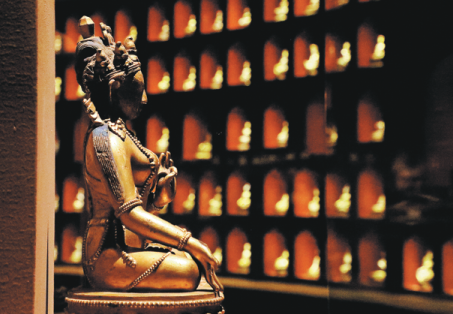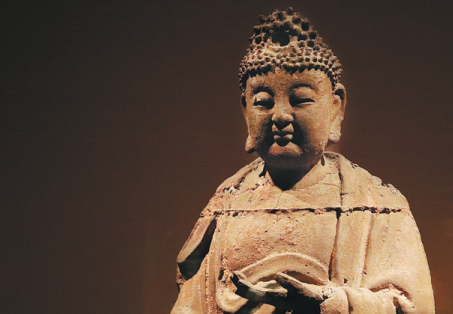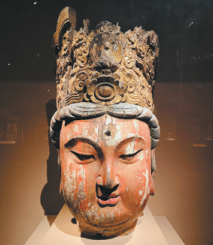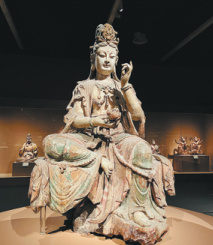Confluence of ideas
A new exhibition highlights the evolution of Buddhist art in China, Lin Qi reports.
Sculptural representations in Buddhism convey people's supreme devotion. They are also testaments to the aesthetic evolution and maturity of workmanship over centuries, promoting their status to an important department at either museums or the art market today.
There are more than 30,000 items of Buddhist art in the National Museum of China's collection, ranging from sculptures to thangka paintings in different media such as gold, bronze, textile and paper, according to Tong Chunyan, a curator at the museum.
A selection of Buddhist sculptures had been on show at the museum since the museum opened in 2011. In December, Tong and her colleagues reorganized the artwork to give this permanent display a face-lift.
The new Ancient Chinese Buddhist Sculpture exhibition gathers 265 fine examples, navigating the evolution of Buddhist art in China.
Buddhism came to China from India roughly 2,000 years ago.
The exhibition shows the most distinctive features of sculptural representations from different dynasties in China and also the maturity of various crafts used to create such works of art. It reflects the extensive cultural exchanges between the Middle Kingdom and other civilizations through the spread of Buddhism, which further enriched the Chinese civilization.
The exhibition begins by introducing the diversity of bronze figures in Buddhism from the ancient Indian subcontinent. Specimens on display cover notable schools of art such as the Gandhara, Mathura and Gupta styles.
"This section traces ancient Chinese Buddhist art to its origin," Tong says, "helping the audience, especially those who are unfamiliar with the field, to have some basic idea before they move on to the development of that art afterward in China."
As Buddhism spread across ancient China, Buddhist art incorporated indigenous aesthetics and regional beliefs to form a distinct style, reflecting the country's cultural landscape.
Tong says her team categorized Chinese art figures by materials, which present ancient artisans' creativity, varying over different periods.
Clay figures dated around the fourth century and the Tang Dynasty (618-907) show craftspeople beginning to blend Chinese physical features into their works, using clay as a more accessible material.
Stone sculptures gradually gained predominance during the same period, as large Buddhist grottoes were constructed in Shanxi, Gansu, Henan and Jiangsu provinces, and several cities like Qingzhou in Shandong province became centers of Buddhism.
Located in the middle of the exhibition space is a 2-meter-high, colored wooden sculpture from the Song Dynasty (960-1279), depicting Guanyin, the Chinese version of Avalokitesvara bodhisattva.
The worship of Guanyin began around the third century, and the earliest Guanyin figure still in existence, believed to have been sculpted between the third and fourth centuries, is now at the Bingling Temple in Gansu.
"Any museum would be proud to own a wooden Song Buddhist sculpture, given the rarity of its kind," Tong says.
The Guanyin figure, which was bought back to China from a private collector abroad in 2005, reflects the reverence for Avalokitesvara after the religion started to spread in China.
The bodhisattva figure, who has male features in Indian Buddhism, gradually took on more female characteristics in China, and in the Song era, the icon was finalized as a female figure: the beard had been replaced by feminine decorative details. And in addition to an association with infinite compassion, the goddess embodied more blessings among a wide population of believers, such as a wish for children.
Tong says her personal favorite at the exhibition is another Song-era wooden Guanyin head that exemplifies an aesthetic transformation from the Tang to the Song dynasties.
"The head presents an admiration of ample physique and majestic elegance, which inherited the artistic style favored in the Tang period. Meanwhile, unlike Tang figures that highlight power and strength, the Song objects deliver a softened tone of beauty," she adds.
Gilt-bronze statues from the Ming (1368-1644) and Qing (1644-1911) dynasties on show celebrate the sophisticated workmanship of casting at the time, making the refined specimens highly sought after by collectors.
Tong says a Ming ceramic figure at the exhibition also deserves attention. It portrays the Wenshu deity, or Manjushri bodhisattva, holding a jade ruyi scepter and sitting on a lion. It was cast in the prestigious Longquan kiln in Zhejiang province, known for producing ceramics that boast grayish-green glaze glittering with tranquil luminosity.
Tong says about two-thirds of the national museum's collection of Buddhist art represent Tibetan Buddhism, and the final section of the exhibition shows a wall of inlaid caves in rows in which dozens of selected statues from Tibetan Buddhism are seated.
"The design is to engage the audience with an artistic atmosphere, thereafter ushering them into the infiniteness of the world of Buddhism," she says.
Contact the writer at linqi@chinadaily.com.cn



















